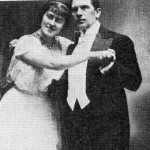Nach der Tangomanie zwischen 1910 und 1930 in Deutschland, England und Frankreich schlossen sich auch andere Länder an, und Tangomusik wurde populär. Eines dieser Länder war Polen, wo Tangos in polnischer Sprache gespielt wurden.
Die ganze Geschichte beginnt bereits 1913 [1], aber die große Zeit des polnischen Tangos war in den späten 1920er Jahren. 1929 wurde der berühmte Tango „Tango Milonga“ (Text und Noten [2]) von Jerzy Petersburski komponiert und wurde mit Adaptionen auf Deutsch („Oh Donna Clara“) und Englisch („Oh Donna Clara“) sofort ein internationaler Hit. Die Texte wurden von Andrzej Włast [3] geschrieben, die deutschen Texte stammen von Fritz Löhner-Beda und die englischen Texte wurden von Irving Caesar und Jimmy Kennedy [4] übersetzt. Ursprünglich wurde der Tango für Stanisława Nowicka geschrieben.
Oh, Donna Clara,
I’ve seen you dancing tonight,
Oh, Donna Clara,
I’m in love with you!
Hier das Originallied in einer alten Instrumentalversion von Henryk Gold und einer neueren Version von Mieczysław Fogg aus dem Jahr 1960.
In den 30er Jahren waren die wichtigsten Tangosänger Tadeusz Faliszewski, Stefan Witas, Mieczysław Fogg, Albert Harris und Janusz Popławski [5].
Hier ist Mieczysław Fogg mit seinem Lied „Ostatnia niedziela“ („Letzter Sonntag“, komponiert von Jerzy Petersburski) aus dem Jahr 1936.
Nur als Kuriosität hier die Übersetzung von „Ostatnia niedziela“ ins Hebräische vom polnischen Schlagersänger Adam Aston. Der neue Titel lautet „To ostatni Szabas“. Wir alle wissen, dass der zeitgenössische Tango eine kleine Affäre mit hebräischer Klezmer-Musik hatte. Auch wenn dieses Lied natürlich kein Klezmer ist, hat diese Romanze vielleicht hier begonnen.
http://www.youtube.com/watch?v=5ha92yBAB-c
Hier sind zwei weitere Lieder, eines von Mieczysław Fogg: „Serce Matki“ („Mutterherz“) und „Juz Nigdy“ („Nie wieder“), gesungen von Sława Przybylska. Dies ist wieder eine Komposition von Jerzy Petersburski.
Für heutige Hörer ist dieser Tango von Janusz Popławski aus dem Jahr 1939 vielleicht besser geeignet. Der Titel lautet „Złociste chryzantemy“, was so viel wie „Goldene Chrysanthemen“ bedeutet. Dies war eines der letzten Lieder vor dem Zweiten Weltkrieg und ein Meisterwerk, das die große Ära des polnischen Tangos abschloss [1].
Viel Spass,
-Richard
References
1 http://www.todotango.com/english/biblioteca/cronicas/tango_en_polonia.asp
2 http://a-pesni.org/popular-in/polska/milonga.htm
3 http://en.wikipedia.org/wiki/Andrzej_W%C5%82ast

